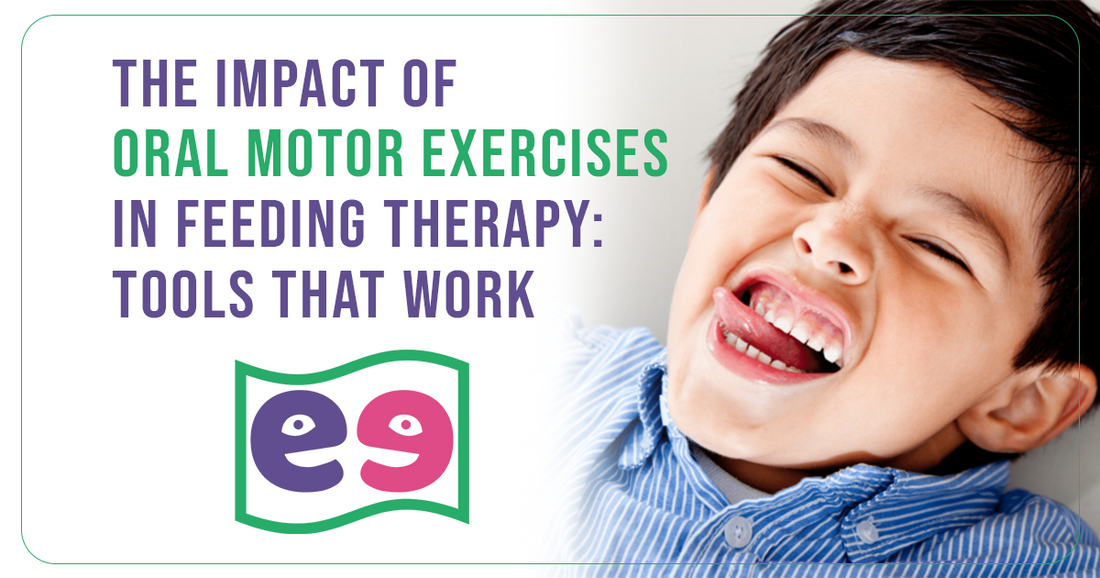Introduction
Feeding therapy is helpful for people dealing with autism. One important tool in this therapy is oral motor exercises, and they bring many benefits for the eating challenges faced by individuals with autism spectrum disorder [ASD].
In this blog, we will explore how oral motor exercise impacts feeding therapy and delve into the feeding tools that effectively enhance the overall experience of individuals and their caregivers.
Understanding Oral Motor Exercises
Oral motor exercises are special activities designed to work on the oral musculatures used for speech and swallowing. They concentrate on making these oral musculatures —like the lips, tongue, jaw, and cheeks—stronger and more coordinated. Strengthening these oral musculatures help people speak more clearly and make precise speech movements. In feeding therapy, these exercises do more than just help with speech; they cover a wide range of movements and stimulations that make the mouth work better. The good effects include improved chewing, swallowing, and overall coordination of oral musculatures.
Why Are These Exercises and Speech Therapy Important?
-
Improved Muscle Tone
Oral motor exercises aim to make the oral musculatures in and around the mouth stronger. These exercises are really helpful for people, especially children, whose oral musculatures are not very strong. By making these oral musculatures stronger, it helps them have better control over their mouth movements, making chewing and swallowing easier and better.
-
Enhanced Sensory Awareness
Individuals who have trouble with eating and sensory issues might not like certain textures and temperatures of food. Oral motor exercises help these people become more aware of their senses, making them feel more comfortable with different feelings in their mouths. This improved comfort level helps them be okay with a wider variety of foods, making their diet more diverse and nutritious.
-
Coordination Development
When a child starts expressing his feelings easily through speaking, he starts making friends and playing with them, which improves his other activities and develops his cognition because speaking requires a lot of focus, attention, reasoning, and imagination.
Feeding Therapy Tools for Effective Oral Motor Exercises
-
Oro Tubes
Oro tubes are flexible tools designed to provide oral sensory input and smoother jaw movement. They come in various shapes and sizes, letting children or individuals chew on them to strengthen their jaw oral musculatures. Adding chewy tubes into feeding therapy helps address oral motor challenges and reduces oral aversions.
-
V-Pen or other stimulation devices
These feeding tools provide sensations to the mouth, making it more aware and responsive. They can be used to gently massage the gums, tongue, and other parts inside the mouth, which helps improve muscle tone and the ability to tolerate different sensations.
-
Sucking Tubes for Drinking Exercises
Drinking through a sucking tube includes mouth movements that make the lips and oral musculatures stronger. When straw-sipping exercises are added to therapy sessions, it helps improve oral motor skills and encourages the right placement of the tongue, making swallowing coordinated and effective.
-
Tongue Depressors and Sensory Bristle
Tools like Tongue Depressors and Sensory Bristle are useful for doing oral motor exercises. They help make sensitive parts of the mouth less sensitive and enhance control over oral movements.
-
Oral Motor Chew Toys
Specially designed chew toys serve as effective tools for oral motor exercises. These toys come in different textures, shapes, and resistance levels, allowing therapists to tailor the experience to each child's needs. By encouraging biting and chewing on these toys, oral motor chew toys help strengthen the jaw and improve oral motor skills.
Strategies for Incorporating Oral Motor Exercises
-
Individualized Approach
Every individual is different, and their challenges with mouth movements are not the same. Making the oral exercises fit each child ensures that the activities help with what that child needs and wants, making the therapy work better.
-
Gradual Progression
Starting oral motor exercises in a step-by-step way, considering the person's comfort and tolerance, is important. Introducing new textures, movements, and sensations gradually helps improve oral motor skills one step at a time.
-
Consistency and Repetition
Doing the same exercises regularly is important for oral motor therapy to work well. Doing them over and over again helps make the skills better over time, giving good results.
-
Collaboration with Caregivers
Caregivers need to work together with therapists on oral motor exercises. This way, they carry out these exercises at home with the therapist's guidance. It helps support and build on the progress made during therapy sessions.
Benefits
Getting better at mouth exercises doesn't only help with eating better. When kids or people improve at these exercises, it often makes other things better, like talking and communicating. Stronger oral musculatures and better control help them talk more clearly and use their voice better, which makes their communication skills improve.
Final Thoughts
Oral motor exercises in feeding therapy work well. They are like strong tools that help with the tricky problems kids and people face when it comes to eating. Therapists and caregivers, by using different tools and smart plans, can work together to help each child or person do better with their mouth skills and feel good about eating.
Moreover, it is a responsibility to choose the right source that provides promising tools for oral motor exercise to children or individuals with ASD. At SpeechGears, we envision becoming a one-stop solution for problems related to autism and related illnesses. We aim to create a society where every person with autism lives a happy and satisfying life.


